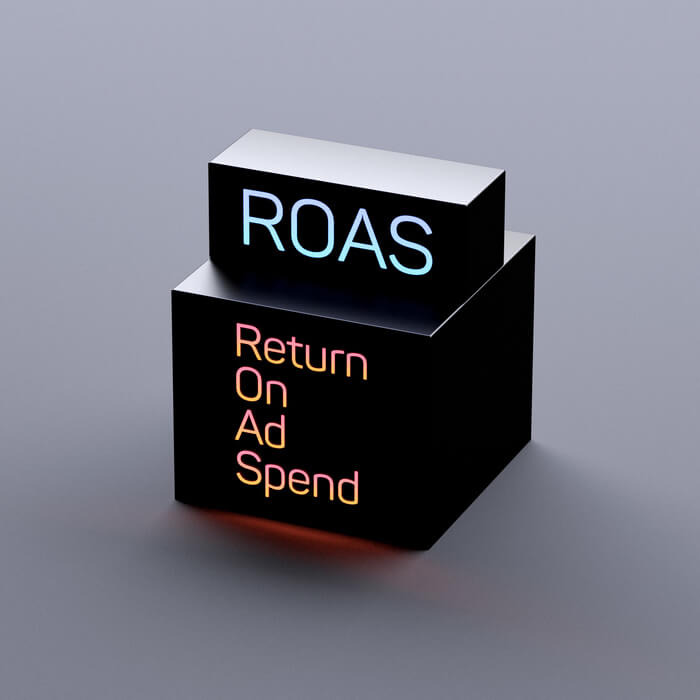
What Is ROAS? Calculating Return on Advertising Spend
Jul 19, 2024|Read time: 5 min.
Key Points
- ROAS, or return on advertising spend is an important marketing metric that measures the effectiveness of a marketing effort.
- ROAS provides an accurate representation of how much money a marketing effort earns per dollar spent and can be applied to nearly any spend.
- Owned asset optimization is a key strategy for achieving substantial ROAS across all the marketing initiatives it touches.
ROAS definition
Marketing term
Return on advertising spend (ROAS)
A key performance indicator (KPI) in digital marketing that represents the effectiveness of a given advertising campaign. ROAS measures the return on investment on each marketing dollar spent and is expressed as a percentage or a ratio.
To gauge ROI and performance, ROAS can be applied to an agency, an entire marketing strategy, and beyond — down to individual advertising efforts. ROAS is useful for numerous applications, including ecommerce marketing and owned asset optimization.
How is ROAS calculated?
Traditionally, the ROAS formula is:
ROAS = Revenue generated from an advertisement / Cost of the advertisement
Let’s say you spent $1,000 on Facebook ads or Google ads and this marketing effort generated $2,000 in revenue.
That means you made $2 on each dollar spent, for a ROAS of 2:1 (or 200% when multiplied by 100.
This is ROAS in its most basic form. But there are other considerations to keep in mind. (More on those later.)
Why ROAS matters
As a KPI, ROAS enables marketers to quickly assess marketing campaign performance on a macro and micro level and then adjust based on that ratio.
It allows for optimizing strategy and comparing marketing options, which reveals the most effective and least effective efforts. That way, you can maximize the impact of your spending.
Efforts that return insufficient or even negative ROAS can be pared back so you can put more money into what’s working.
Optimizing to improve ROAS
In our paid ad campaign example above, calculating your ROAS may reveal opportunities to tweak ad creative to improve click-through rate, perform conversion rate optimization (CRO) on the ad’s target page, alter specs to impact cost per click (CPC), or even reprioritize to other marketing options completely.
Brands can calculate ROAS across their digital marketing strategies. It’s a useful comparative metric not just for individual ads but also to help evaluate and choose the best marketing partners.
ROAS marketing metric considerations
While ROAS seems simple in principle, getting the data needed to determine the exact cost and revenue is often more complex.
First, you must ask if you can tie a value to the outcome of this particular marketing effort. Not all marketing is meant to directly generate revenue, but you still need to associate a value with the outcome to accurately calculate ROAS.
Second, is the cost you determined inclusive of every single factor needed to execute the particular marketing effort? Does it include commissions, fees, and agency costs?
Gathering the total cost is vital to understand the ROAS and profit margin of a marketing effort.
Accuracy of ROAS calculations
Typically, ROAS compares performance to cost, but it should also include fees associated with any external marketing partner that developed and executed the strategy.
You should also consider affiliate costs, salaries, design costs, and transaction fees. Without the full picture of spending, your ROAS number will be artificially inflated and misleading.
An artificially high ROAS due to excluded costs is a major pitfall that can lead to spending allocation errors.
For instance, in our above 2:1 ROAS example, what if you neglected to include the ad creative design costs? That’s right — the 2:1 ROAS would be artificially higher than reality.
Attribution models
Another aspect of the ROAS calculation is how you assign attribution to determine where revenue credit is given. Attribution models include:
- First-touch attribution: Single-touch model that assumes a conversion on the first advertisement a consumer engaged with.
- Last-touch attribution: Single-touch model that assumes a conversion on the last advertisement a consumer engaged with.
- Multi-touch attribution: Model that gives credit to all touchpoints, which helps marketers get a more accurate cost and revenue number.
Multi-touch attribution is the ideal model to apply as it results in a much more accurate ROAS calculation. This model ensures all costs, as well as value, are accounted for.
ROAS vs. ROI vs. ACOS
Here’s a quick look at return on advertising spend, return on investment (ROI), and advertising cost of sale (ACOS), terms that can easily be mixed up. Here are the key differences between the three:
ROAS: a KPI that represents the effectiveness of a given advertising or marketing campaign, revealing how much money a campaign generates per dollar spent.
ROI: A performance metric that compares profit against cost to determine the return on a given investment. ROI reveals overall profitability, whereas ROAS targets the effectiveness of a given campaign or strategy.
ACOS: A KPI that tells you how much was spent on advertising for each dollar made. It’s another side of the ROAS coin that expresses the cost first instead of the revenue. Often used in pay-per-click (PPC) and Amazon ads.
ROAS — the core marketing KPI
In digital marketing, you need a central KPI to compare the performance of agencies, as well as other marketing partners and approaches.
ROAS’ unique value
We believe ROAS is the most insightful metric to use when comparing marketing efforts between partners as well as across strategies and channels.
ROAS is a straightforward cost-versus-value metric for marketing effort comparisons. It also provides insight into the overall health of your marketing campaigns.
ROAS and OAO
You can also begin tracking the impact of CRO and other optimizations on your owned assets. As they start to connect with and convert more customers, your ROAS should increase across all marketing efforts.
That’s why we love owned asset optimization as a holistic marketing strategy — it addresses all aspects of achieving superb ROAS results.
OAO creates authentic consumer connections across all brand properties through:
- Optimized experience
- Maximum consistency
- Conversion optimization
- Optimized technical specs
It builds the required foundation your campaigns need to closely align with consumer needs.

OAO boosts ROAS by ensuring all your efforts deliver what people actually want, increasing CTR, transactions, and engagement.




